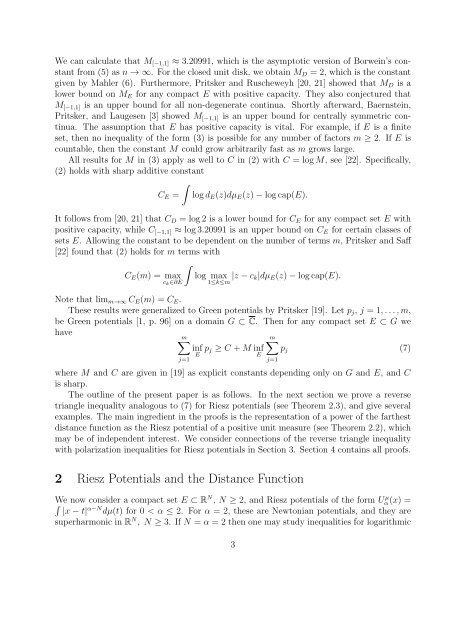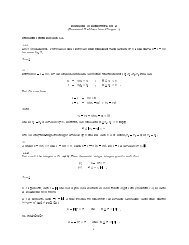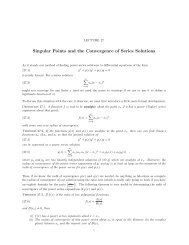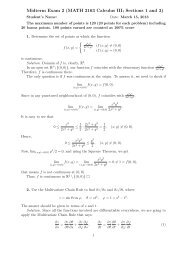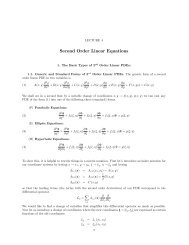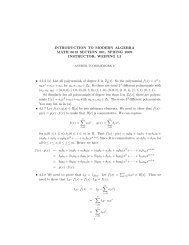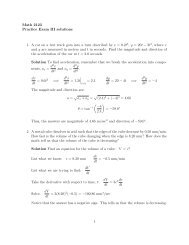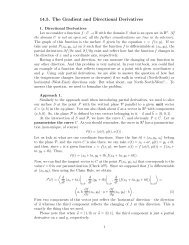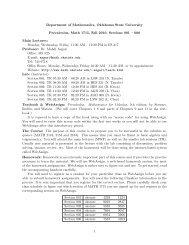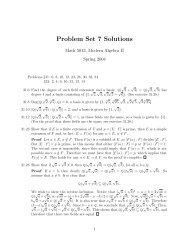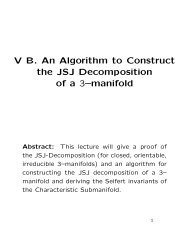Reverse Triangle Inequalities for Riesz Potentials and Connections ...
Reverse Triangle Inequalities for Riesz Potentials and Connections ...
Reverse Triangle Inequalities for Riesz Potentials and Connections ...
Create successful ePaper yourself
Turn your PDF publications into a flip-book with our unique Google optimized e-Paper software.
We can calculate that M [−1,1] ≈ 3.20991, which is the asymptotic version of Borwein’s constantfrom (5) as n → ∞. For the closed unit disk, we obtain M D = 2, which is the constantgiven by Mahler (6). Furthermore, Pritsker <strong>and</strong> Ruscheweyh [20, 21] showed that M D is alower bound on M E <strong>for</strong> any compact E with positive capacity. They also conjectured thatM [−1,1] is an upper bound <strong>for</strong> all non-degenerate continua. Shortly afterward, Baernstein,Pritsker, <strong>and</strong> Laugesen [3] showed M [−1,1] is an upper bound <strong>for</strong> centrally symmetric continua.The assumption that E has positive capacity is vital. For example, if E is a finiteset, then no inequality of the <strong>for</strong>m (3) is possible <strong>for</strong> any number of factors m ≥ 2. If E iscountable, then the constant M could grow arbitrarily fast as m grows large.All results <strong>for</strong> M in (3) apply as well to C in (2) with C = log M, see [22]. Specifically,(2) holds with sharp additive constant∫C E = log d E (z)dµ E (z) − log cap(E).It follows from [20, 21] that C D = log 2 is a lower bound <strong>for</strong> C E <strong>for</strong> any compact set E withpositive capacity, while C [−1,1] ≈ log 3.20991 is an upper bound on C E <strong>for</strong> certain classes ofsets E. Allowing the constant to be dependent on the number of terms m, Pritsker <strong>and</strong> Saff[22] found that (2) holds <strong>for</strong> m terms with∫C E (m) = maxc k ∈∂Elog max1≤k≤m |z − c k|dµ E (z) − log cap(E).Note that lim m→∞ C E (m) = C E .These results were generalized to Green potentials by Pritsker [19]. Let p j , j = 1, . . . , m,be Green potentials [1, p. 96] on a domain G ⊂ C. Then <strong>for</strong> any compact set E ⊂ G wehavem∑j=1infEp j ≥ C + M infEm∑p j (7)where M <strong>and</strong> C are given in [19] as explicit constants depending only on G <strong>and</strong> E, <strong>and</strong> Cis sharp.The outline of the present paper is as follows. In the next section we prove a reversetriangle inequality analogous to (7) <strong>for</strong> <strong>Riesz</strong> potentials (see Theorem 2.3), <strong>and</strong> give severalexamples. The main ingredient in the proofs is the representation of a power of the farthestdistance function as the <strong>Riesz</strong> potential of a positive unit measure (see Theorem 2.2), whichmay be of independent interest. We consider connections of the reverse triangle inequalitywith polarization inequalities <strong>for</strong> <strong>Riesz</strong> potentials in Section 3. Section 4 contains all proofs.2 <strong>Riesz</strong> <strong>Potentials</strong> <strong>and</strong> the Distance FunctionWe now consider a compact set E ⊂ R N , N ≥ 2, <strong>and</strong> <strong>Riesz</strong> potentials of the <strong>for</strong>m U µ α(x) =∫|x − t| α−N dµ(t) <strong>for</strong> 0 < α ≤ 2. For α = 2, these are Newtonian potentials, <strong>and</strong> they aresuperharmonic in R N , N ≥ 3. If N = α = 2 then one may study inequalities <strong>for</strong> logarithmic3j=1


